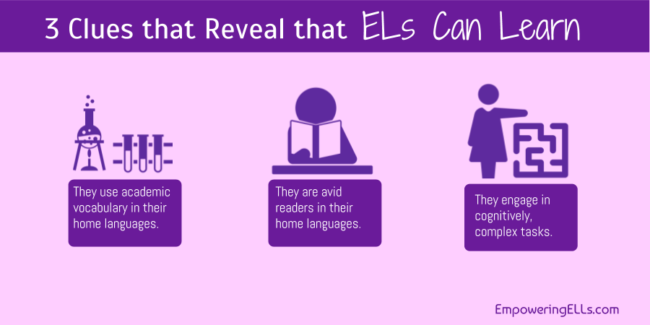
Some teachers complain that their ELs aren’t as bright as their other students who are native users. Usually, they think this because the ELs are not using English fluently or accurately, not because of an actual discrepancy in intellectual ability.
This is a terrible perception to hold because it plagues how the teacher interacts with the ELs – what assignments they give them, how they speak to them, even how they look at them. Lessons become less cognitively challenging, the teacher can become impatient, and the ELs are often ignored.
We need to advocate for ELs all of the time, but especially in instances where their content teacher may be brushing them aside. We need to teach our fellow teachers that there are three important clues that reveal an EL’s capability.
1. Using Academic Vocabulary in Their Home Language
If an EL can use academic vocabulary in their home language, it reveals that an EL can indeed comprehend and use complex vocabulary in general. They are not intellectually incapable of doing so. For example, a beginning EL, Ayaka was required to explain why she chose a particular design for her egg-parachute, which was a task for her Design class.
Because her English skills were still on the word-learning level, Ayaka had to use Google Translate to explain her thinking. In explaining one complex element of the assignment, she said, “that the tension does not remain in one place (distributed)”.

To the observant teacher, this simple phrase reveals several things, that:
- Ayaka understood concepts such as tension and weight distribution
- She understood the task itself
- She had a logical reasoning for her design
- She could use academic Japanese vocabulary
- She understood how to use parentheses
Though her sentence was grammatically and structurally unpolished, her idea itself reveals critical thinking. Instances like this one remind us how underneath their developing English skills, many ELs have established, academic language skill in their home language.
Our role is to tap into that asset and use it to:
- Learn language
- Develop English language, and
- Boost their confidence
2. Reading Avidly
Another positive indicator of established academic skills is when ELs read in their home language. I devote 15 minutes to voluntary free reading each class lesson. Students are free to read in any language during this time because using literacy skills in one language transfers to another (Cummins, 2000).
Ryan, a Beginning ELs, loves to read in Korean. He devours lengthy Korean novels in one series. One day, he came into class with To Kill a Mockingbird in Korean. He had already read half of the novel.

To check his understanding, I had him write notes about what he read. These notes reveal that:
- Ryan can read without the aid of pictures.
- Ryan can remember various complex characters and series in an extended text.
- Ryan can read complex narratives.
When I asked him to read aloud in Korean, I noticed how easily and fluently he was reading, which is also another indicator of his developed language skills in Korean.

To Kill a Mockingbird in Korean.
Ryan’s love of reading in Korean brings me great hope that he will be able to transfer his literacy skills in Korean to aid his comprehension of English. When I teach him to read more complex texts in English, I can have him apply the skills he uses to comprehend Korean novels.
3. Engaging in Challenging Tasks
The most promising sign that an EL is capable of producing quality work is his ability to engage in challenging tasks.
In the image below, we see a task assigned in history class. The teacher gave students two images to look at. They then had to analyze the differences and draw conclusions from the resources. Additionally, they had to apply the information they already had related to the two images.
This task is academically rigorous because it requires students to compare, analyze, and apply.
Even though Zheng Hong, another Beginning EL, was learning English at the word and phrase level, he engaged with this task well. He Google Translated parts of the instructions that he didn’t understand and also translated his answers when his current vocabulary level lacked the words to communicate his ideas.
For example, he translated the sentence, “I think these details reflecting the hardship of the people living in that era.” This sentence is not grammatically correct, but the teacher is still able to assess his understanding from it.
His answer revealed several things:
- Zheng Hong was able to think critically when examining two different resources.
- Zheng Hong could use metaphorical language such as “reflecting”.
- Zheng Hong has an academic Chinese vocabulary because he knows the words “hardships” and “era”.
Takeaways
Students do their best with what they have. Their best in English, unfortunately, can’t always reflect the best they can do in their home languages. And that causes some teachers to believe their EL students are less intelligent than they really are.
But we have to read beyond the words ELs write and speak and pay attention to the small signs that reveal how capable ELs are. When we search for these little clues, we will be rewarded with a renewed belief in their abilities. If teachers have to hold positive perceptions of their students, then their ELs will rise to the teacher’s level of expectation.
Cummins, J. (2000). Language, Power and Pedgogy: Bilingual Children in the Crossfire. Clevedon: Multilingual Matters.

